In the fast-paced world of social media, trends emerge and vanish in the blink of an eye. One of the most recent and controversial phenomena is the Homeless Man AI TikTok Trend, also known internationally by terms like the "AI Zwerver" or "Zwerver Filter" phenomenon. The viral Homeless Man AI TikTok Trend involves leveraging powerful AI image generators to create realistic pictures of a homeless man inside a home as a prank. Here, we dive into the steps of how to do the homeless man AI prank, identify the popular AI homeless man prank app/filter, and show how to use Filmora's AI features responsibly for your video projects.
In this article
Part 1. What is the Homeless Man AI Prank? (AI Zwerver Trend Explained)
The controversial phenomenon, often searched as the homeless man ai trend or sometimes the "ai zwerver" trend, rapidly gained traction across global social platforms. This viral sensation involves users leveraging powerful artificial intelligence image generators to create startlingly realistic pictures of a homeless person seemingly inside their private living spaces... It's essential to understand that while many refer to it as a filter (like the "zwerver filter"), this level of manipulation is the result of advanced AI generation, not a simple AR effect.

A Viral Sensation on TikTok and Snapchat
The trend's mechanics are simple yet deceptive. A user takes a mundane photo of a room in their house. They then upload this image to an AI tool and provide a text prompt, such as "add a disheveled man sleeping on the couch." The AI generates a new image, seamlessly blending the fictional character into the real-life setting. The final step is sharing this image and the subsequent text conversations on platforms like TikTok, where compilations of panicked parental responses have garnered millions of views. These videos often follow a predictable but effective formula: the initial image, a flurry of increasingly worried texts from a loved one, and finally, the prankster's reveal. The combination of high-tech deception and raw human emotion has proven to be a potent recipe for virality.
AI Homeless Man App/Filter: Origins and Key Platforms Explained
While its exact point of origin is debated, the homeless man ai prank (or the so-called ai zwerver filter) appears to have first gained traction in late September 2025. The trend likely began with users experimenting with the new AI features available on Snapchat Plus before exploding in popularity with the broader availability of powerful tools like Google's Gemini image generator. The viral nature of the AI zwerver images demonstrates how quickly new AI technology can be adopted and adapted for controversial social trends.
Why the AI Homeless Man Prank Blew Up on TikTok/Snapchat (The Technology)
The homeless man ai trend is not the result of sophisticated photo editing skills but rather the accessibility of advanced AI. The technology at its core is a testament to how far generative AI has come, enabling anyone with a smartphone to create convincing digital forgeries in seconds.
The Power of AI Image Generators
The core technology is known as text-to-image generation. Modern AI models are trained on vast datasets containing billions of images and their corresponding text descriptions. This training allows them to understand the complex relationships between words, objects, styles, and contexts. When a user provides a text prompt, the AI doesn't just search for a matching image; it generates a brand-new one from scratch based on its learned understanding. For this specific trend, users employ a technique called "inpainting" or image-to-image generation, where the AI is instructed to modify an existing photo. It analyzes the base image's lighting, shadows, perspective, and textures to ensure the newly added element—the ai homeless man—looks like a natural part of the scene rather than a poorly pasted cutout.
Key AI Image Generators Fueling the Homeless Man Prank (Snapchat AI, Gemini, Midjourney)
While the trend is often associated with a generic homeless man filter, it isn't a single filter but rather the output of several powerful, publicly available AI platforms. The tools most commonly cited in viral videos include:
- Snapchat Plus AI: An early incubator for the trend, its integrated AI features made it easy for users to experiment directly within a popular social app.
- Google Gemini (formerly Bard): A highly capable and accessible multimodal AI that can interpret user prompts and generate high-quality, realistic images.
- Midjourney: A well-known AI image service famous for its artistic and hyper-realistic outputs, often used by those seeking the most convincing results.
- DALL-E 3: OpenAI's image generator, integrated into tools like ChatGPT Plus and Microsoft Designer, is another popular choice for its ease of use and high-fidelity creations.
- Media.io and other web-based tools: Numerous free and paid online generators offer similar functionalities, making the technology widely accessible.
These tools have democratized digital manipulation, putting capabilities that once required professional software and expertise into the hands of casual users.
Part 2. Step-by-Step: How to Do the Homeless Man AI Prank (App/Filter Guide)
These tools have democratized digital manipulation, putting capabilities that once required professional software and expertise into the hands of casual users.
- Prank Setup: What you need (a room photo, a prank target).
- Identify the App/Tool: Mention that the AI homeless man app is typically Snapchat+ AI or a dedicated generator like Midjourney/Gemini.
- Prompt Strategy: Provide sample prompts like [Your room description], add a homeless man sleeping on the floor, realistic photo, hyper-realistic, high detail.
- The Prank Execution: How to send the image and get the reaction.
Using Filmora AI Tools for Ethical and Responsible Video Creation
The controversy surrounding the homeless man ai trend doesn't mean that AI image generation is inherently bad. On the contrary, it is an incredibly powerful tool for creativity, art, and innovation. The key lies in using it responsibly and ethically. Instead of creating content that relies on harmful stereotypes or causes distress, creators can harness AI to produce stunning, original, and positive visuals.
Step1Open Wondershare Filmora's AI Image Generator and upload a clear indoor photo.
Go to Wondershare Filmora's AI Image Generator. Upload a clear photo of your room or workspace. This will serve as your base image for creating a responsible, story-driven Homeless Man AI scene—focused on empathy, not shock value.
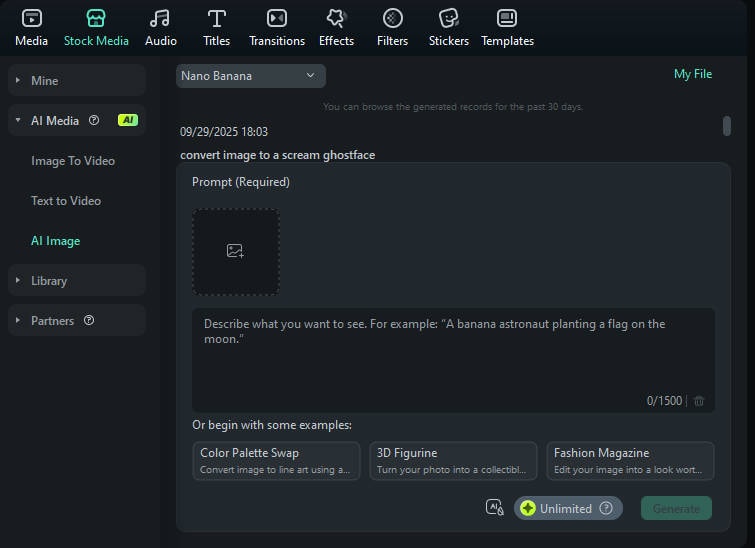
Step2Write a thoughtful AI prompt describing a scene that conveys empathy and awareness.
Instead of using AI for pranks or deception, focus on prompts that tell meaningful stories or raise awareness about homelessness and compassion. Specify the style, lighting, and mood to ensure your image is both respectful and artistic.
Prompt Example 1 (Realistic Portrait): "A middle-aged homeless man standing at a doorway, smiling gently while holding a worn canvas bag. Soft morning light, documentary realism, cinematic tone, evokes empathy and dignity."
Prompt Example 2 (Awareness Concept Art): "Digital art showing a homeless man sitting peacefully in a park, surrounded by subtle symbols of hope—sunlight, greenery, and warm tones. Inspirational and humanizing aesthetic."
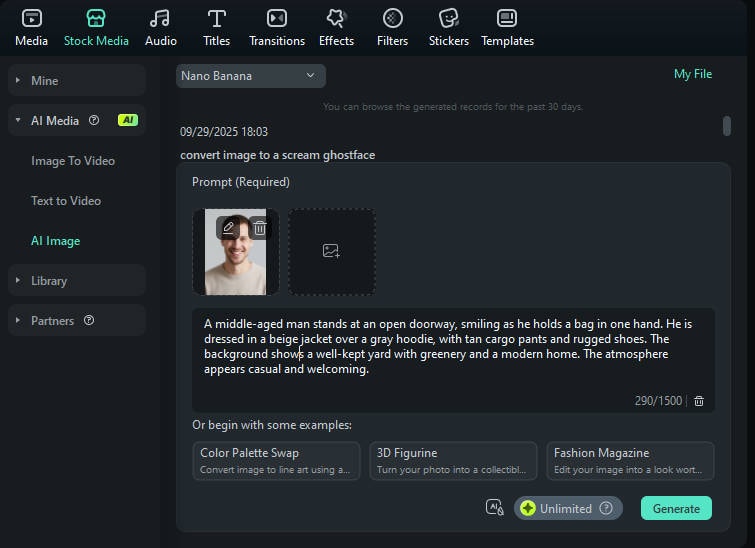
Step3Generate, refine, and share responsibly with awareness-focused hashtags.
Enter your prompt and generate several versions. Refine to achieve the right tone—respectful, emotional, and visually balanced. Once satisfied, download and share your creation on social platforms using awareness-oriented tags like #HomelessManAI, #ResponsibleAI, or #AIEthics.

Part 3. Beyond the Prank: Create Viral Videos with Filmora's AI Tools (Steps & Responsible Use)
Creating a stunning AI image is just the beginning. The next frontier for creative expression is animating these static visuals, transforming them into dynamic, engaging video clips. This process, once the exclusive domain of professional animators, is now accessible to everyone thanks to AI-powered video features.
Using Filmora Mobile App to Create Homeless Man AI Awareness Videos
Step 1 Launch Filmora Mobile and Access Image to Video
Download and install Filmora Mobile from the Google Play Store or Apple App Store. Open the app, tap on "Image to Video". Then, select your AI-generated image depicting the Homeless Man AI scene and tap "Import" to begin.

Step 2 Generate Your Homeless Man AI Story Video
Once your image is imported, Filmora's AI automatically applies motion effects to bring your still picture to life. Choose realistic camera movements such as slow zooms or gentle pans to add emotional depth. You can also include text overlays or captions that promote empathy and awareness about homelessness. Tap "Generate" to create your video, and preview the result once the rendering is complete.

Step 3 Edit and Export Your Awareness Video
Enhance your Homeless Man AI awareness video with gentle background music, filters, and subtitles for storytelling. You can add voiceovers to share a meaningful message about compassion, social awareness, or digital responsibility. Once satisfied, tap "Export" in the top right, select your preferred resolution, and save the video. Share it on social media using hashtags like #HomelessManAI, #ResponsibleAI, and #AIEthics to inspire thoughtful conversations online.

How to Turn Homeless Man Images into Videos on Desktop
Step 1 Open Filmora and Access AI Image to Video
Ensure you have the latest version of Wondershare Filmora installed. If not, download it from the official website. Launch Filmora, open the "Stock Media" menu, and select "AI Image to Video" to begin creating your Homeless Man AI awareness video.
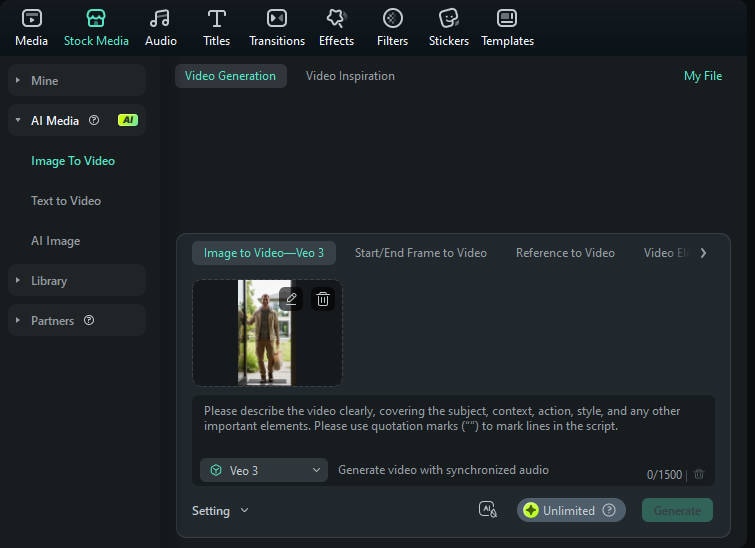
Step 2 Choose Custom Option and Generate Homeless Man AI Scene
Inside the AI Image to Video window, select "Custom". Upload your AI-generated image of a homeless man—crafted with empathy and realism—and type a thoughtful, descriptive prompt in the box. You can mention lighting, emotion, and movement to enhance storytelling. Choose between "Standard Mode" for quick results or "Advanced Mode" for more control, then click "Generate" to bring your image to life.
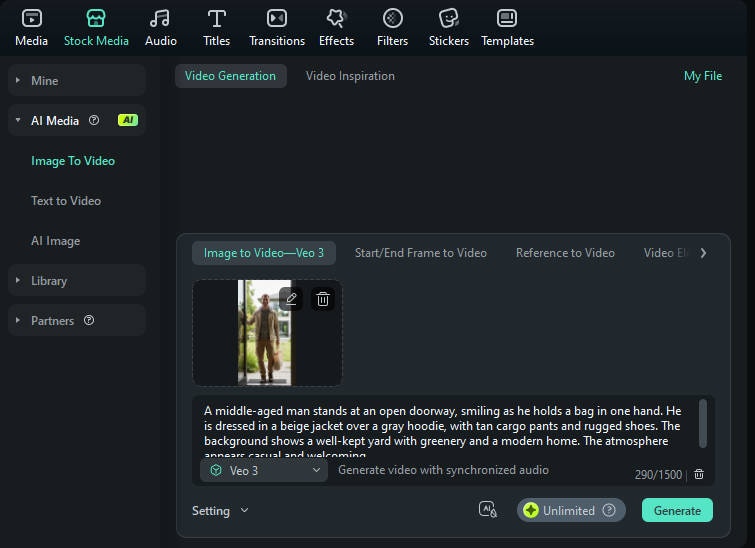
Step 3 Edit Your Awareness Video
Once the video is generated, drag it to the timeline. Add gentle background music, captions, or quotes that promote compassion and social awareness. You can use Filmora's filters, overlays, and transitions to emphasize emotional storytelling and respect for your subject.
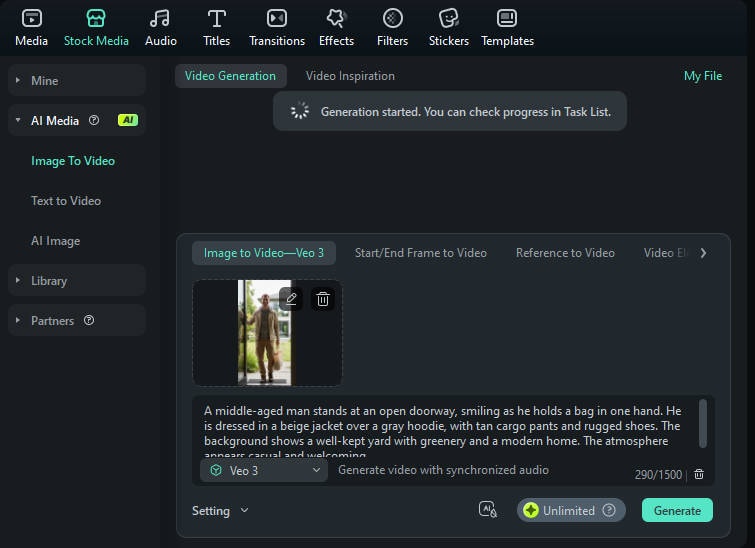
Step 4 Save and Share Responsibly
When your edits are complete, click "Export" in the top right. Choose "Local" to save it on your device, or "Social Media" to share directly. Set your preferred name, format, and resolution, then hit "Export" again to finalize. When posting online, use hashtags like #HomelessManAI, #AIEthics, and #ResponsibleAI to encourage positive dialogue and responsible AI use.
You're done! With Filmora's AI Image to Video feature, you can turn still AI-generated images into meaningful awareness videos—telling stories that inspire empathy, reflection, and ethical creativity.
Love experimenting with viral AI filters? Once you've mastered the Homeless Man AI prank, why not take it further — see who your AI twin might be!
Read our trending guide: Find Your Doppelgänger Online: Free AI Tools to Spot Your Look-Alike
Part 4. Ethical Risks & Real-World Consequences
What began as a seemingly harmless prank quickly descended into a significant ethical controversy. While creators of the trend may have intended it as a lighthearted joke, the homeless man ai prank has been widely condemned for its lack of empathy and its dangerous real-world consequences, sparking a much-needed conversation about the responsible use of AI.
Why the Homeless Man AI Prank Is More Than a Joke
The central ethical criticism revolves around the trivialization of homelessness. By turning the image of an unhoused individual into a prop for online entertainment, the trend exploits the vulnerability of one of society's most marginalized groups. Critics argue that it dehumanizes people experiencing homelessness, reducing their plight to a cheap scare tactic. The humor, if any, is derived from punching down, using a stereotype rooted in fear and prejudice to elicit a reaction. Many commentators and even individuals with lived experience of homelessness have expressed their disgust, stating that the trend reinforces negative perceptions and demonstrates a profound lack of compassion. It transforms a serious social crisis into fleeting, thoughtless content, stripping it of its human context for the sake of clicks and likes.
Real-World Consequences: Panic and Wasted Resources
The hyper-realism of the AI-generated images has led to consequences that extend far beyond hurt feelings. There have been numerous documented cases where the prank caused genuine panic. Believing their child or loved one was in immediate danger, terrified parents have called emergency services. As a result, police and other first responders have been dispatched to homes, only to find the "intruder" was a digital ghost.
Law enforcement agencies in several regions have issued public warnings, urging people to stop participating in the trend. They highlight that such false alarms divert critical resources away from genuine emergencies, where seconds can mean the difference between life and death. One particularly stark example covered by outlets like the International Business Times involved a TikTok user being interrogated by police after their prank went too far. These incidents underscore that the line between a digital joke and a public safety threat can be dangerously thin.
The Broader Debate on AI Misuse and Digital Literacy
The homeless man ai trend serves as a powerful case study in the broader challenges of the AI era. It highlights the growing problem of AI-generated misinformation, or "deepfakes," and their potential to sow confusion and panic. Furthermore, it reveals a significant gap in digital literacy, particularly between younger, tech-savvy generations and their older relatives who may be less equipped to distinguish a sophisticated AI fake from reality. The trend forces us to confront difficult questions: Where do we draw the line between creative expression and harmful deception? What responsibility do users and platforms have to prevent the misuse of these powerful tools? As AI becomes ever more integrated into our lives, these are questions that demand serious consideration from society as a whole.
Conclusion
The homeless man ai trend serves as a powerful and timely reminder of the dual nature of technology. It demonstrates how a tool with immense creative potential can be easily misused for thoughtless and harmful purposes. The rapid viral spread and the ensuing controversy underscore the urgent need for a collective conversation about digital ethics and user responsibility in the age of generative AI.
However, the future is not bleak. For every person misusing AI for a tasteless prank, there are thousands more using it to break down creative barriers, tell compelling stories, and produce art that was once unimaginable. Tools like those found in Wondershare Filmora are at the forefront of this positive movement, empowering creators to enhance their storytelling responsibly. As we move forward, the challenge for all of us—creators, consumers, and developers—is to champion the ethical application of AI, fostering a digital environment where innovation and empathy go hand in hand. The power is in our hands; it's up to us to use it wisely.
Frequently Asked Questions
-
What is the AI homeless man trend on TikTok?
The AI homeless man trend is a social media prank predominantly seen on TikTok. Participants use AI image generators to create a realistic but fake image of a homeless person inside their home. They then send this image to a family member or friend with a panicked message to provoke and record their shocked reaction for online content. -
Is the homeless man AI prank illegal?
While creating the AI image itself is not illegal, the consequences of the prank can lead to legal trouble. Causing a public disturbance or knowingly filing a false police report (which can happen if a panicked recipient calls 911) is a punishable offense in many jurisdictions. Authorities have warned that those who cause emergency services to be dispatched for a prank may face fines or other penalties. -
How to use AI image generators responsibly (Filmora AI Image Generator)?
There isn't a specific "homeless man filter." The effect is created using text-to-image AI generators like Google Gemini or Midjourney with a descriptive prompt. However, due to the ethical concerns and potential for causing harm, this guide strongly recommends against creating such content. Instead, we encourage using AI tools like the Filmora AI Image Generator for positive and creative purposes, such as generating artistic visuals, fantastical scenes, or unique assets for video projects. -
What are the ethical concerns of the homeless man AI trend?
The primary ethical concerns are multifaceted. First, it exploits and dehumanizes a vulnerable population—people experiencing homelessness—for the sake of entertainment. Second, it can cause genuine emotional distress and panic for the recipients of the prank. Third, it leads to the wasting of vital emergency resources when police are called. Finally, it contributes to the broader problem of digital misinformation and erodes trust in visual media.



 100% Security Verified | No Subscription Required | No Malware
100% Security Verified | No Subscription Required | No Malware


